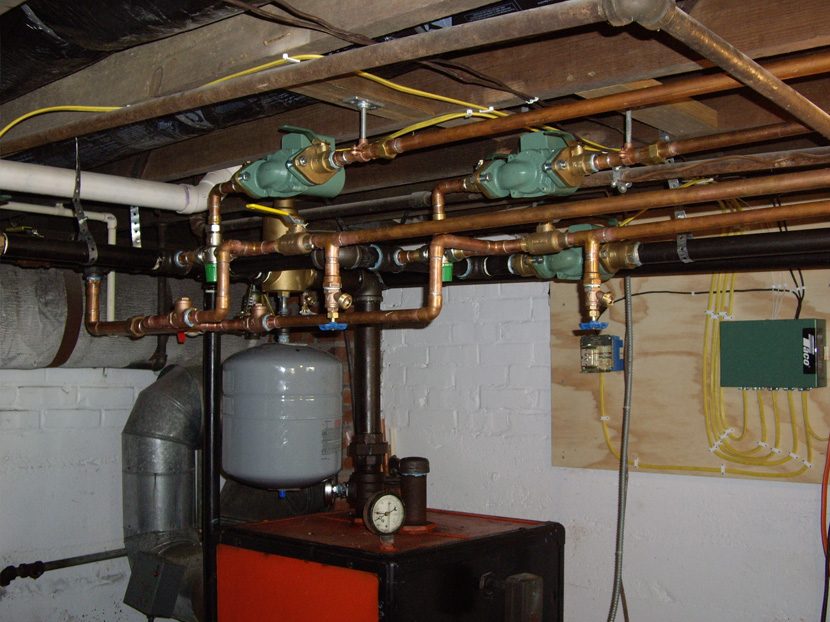My First Hydronic System
The mystery of an old system and the discovery of reliable resources.



Most of us in the business of heating remember the first hydronic system we worked on. For me, it was an experience steeped in mystery, discovery and fascination.
See, although I may have held myself in high esteem, I really didn’t know too much about hydronics at the time. But I wasn’t about to let a trivial matter like that stop me. I wanted to do the job, so I did!
It may have cost me money instead of making me money, but that was another trivial matter. Once I experienced the exuberance of turning the system on and watching everything work, the money I lost was forgotten. I had done this with my own hands, and it felt good.
I wasted hours in that little basement watching the gauges and feeling the pipe warm up. I got to experience the smell of black-iron pipe heating up for the first time. The fragrance was like crack to me. Not wanting anyone else to miss out on this wondrous experience, I was dragging everyone who was unfortunate enough to be at the house down into that little basement to share my enthusiasm.
In hindsight, I’m quite certain they were more fascinated with my elation and cared less about an old boiler with big rusty piping. I couldn’t see it at the time.
The home where this all took place is a source of fascination in and of itself. It was an old Sears & Roebuck kit home. I know it sounds weird to us today, but in the early-1900s, you could order your home from the Sears catalog. All you had to do was provide the manpower to put everything together.
This particular model was called “The Collingwood,” which was available for purchase from 1933 to 1940.
Here is an excerpt from the advertisement:
“Here is an unusual bungalow, well-suited for modern living conditions. The exterior is very practical and finds much favor on account of its simplicity. The lines of the hip roof are broken by the dormer on the front and bay projection over the dining room at the side. Living out of doors, as most of us do in summer, the front porch will be appreciated. The windows are very well-designed and attractively arranged.
“The Living Room. From the front porch, we enter the living room which is 12 feet, 9 inches wide by 18 feet, 5 inches deep. Note the convenient and attractively designed fireplace in the left wall, on each side of which is a window, and the triple window in the front hall.
“The Dining Room. The dining room is located next to the living room and is lighted by two large windows contained in the bay projection.
“The Kitchen. From the dining room, we pass into the kitchen where considerable thought has been given to the placing of many built-in features and practical arrangement of other equipment. The kitchen sink is located underneath the double window on the left wall, on each side of which suitable kitchen cabinets are furnished at option prices. A place for brooms, mops, etc., is formed by the closet opening off the right wall. The built-in breakfast alcove occupies the space at the rear. Table and seats for this furnished at option price.
“Bedrooms. A plastered arch is used in the opening between the dining rooms and hall, which connects the two bedrooms and bath.
“What our Price Includes
“At the base price quoted, we guarantee to furnish all material consisting of lumber, lath, millwork, flooring, shingles, building paper, hardware, metal and painting materials according to specifications. See attached price list for base price and options.”
And you could have it all for the low, low price of $1,497!”
Gravity heat
The heating system was hot water, of course. About the only central heating systems available during that time period were either steam or hot water. Anyone who could afford central heating had one or the other.
The house, when ordered, came with darn near everything except a basement, which had to be dug in order to install the boiler.
This particular basement was dug by hand. “Roomy” would be about the least accurate word to describe the hole they hollowed out of the ground.
I can’t say that I blame them. Digging by hand is not an easy chore.
After they had the hole dug, they constructed a box out of 12-inch boards and set it down in the hole. This served as a concrete form. The concrete was then poured on the outside of the form, right against the dirt wall of the hole.
Into this little pit, they placed a beautiful old cast-iron coal boiler. The boiler had an enameled steel jacket, elegantly trimmed in black and orange.
With the boiler in place, they built the house on top of it. The boiler is still in the hold, and I pity the bloke who has to take it out someday.
This boiler not only heated the house, it also heated the DHW.
The appendage wrapped in white asbestos insulation that juts off the left side of the boiler is actually a water heater.
I know, it doesn’t look like any water heater you’ve seen before. Neither had I. But this is actually a neat and elaborate setup for the time.
See, this was a gravity heating system, which means it didn’t use a pump to circulate the water from the boiler through the radiators.
As the boiler heated up the water, it expanded and became less dense. This would, in turn, lower the volumetric weight of the water.
The water in the return piping was cooler and, therefore, heavier. Its weight pushed into the bottom of the boiler, forcing the lighter heated water out of the top and out through the mains to the radiators.
The water heater worked on the same principle.
When you turned on a hot water faucet, the cold water would enter the bottom of the water heater/heat exchanger. As it absorbed heat, it would cool off the boiler water.
The cooled-off boiler water would then drop straight down the vertical return pipe into the bottom of the boiler. This would push hotter water out of the top of the boiler and into the top of the water heater.
This works as a continuous cycle as long as the boiler stays hot. But what about when the oil burner turns off, you ask?
Ahh, you see the oil burner wasn’t there when this boiler was installed. This boiler used to burn coal, which made heat all the time.
At some point in history, oil heating became all the rage. No more coal dust! Some oil man came along and installed an oil burner on this boiler and added a thermostat at some point.
But what about summer time? How did they get DHW then? If it’s a gravity heating system, wouldn’t the radiators get hot and overheat the house if you leave the boiler on to generate DHW?
Good question. See those two King valves on the mains, right above the boiler? All you had to do is turn those off. Then you could burn coal at any time during the summer and not worry about heating the house.
What about the expansion tank? When the water heats up and expands, the extra water has to go somewhere, right?
Indeed! They didn’t have pneumatic, bladder-type expansion tanks we are used to seeing these days. In those days, taking care of water expansion was a bigger deal than threading a small, featherweight tank into a 1/2-inch fitting.
Instead, they ran a pipe from the boiler all the way up into the attic. In the attic, the pipe would enter the bottom of a cylindrical tank, about the size of a five-gallon bucket. This was the expansion tank.
Out of the top of the tank ran a vertical overflow pipe. This went up through the roof. In the event someone overfilled the boiler, the excess water would be dumped out onto the house roof and prevent water damage from occurring inside the house.
What kept the tank in the attic from freezing, you ask?
Another good question. The pipe that ran from the boiler up to the expansion tank was installed so it always sloped up or was vertical. This allowed for some thermal migration in the pipe, allowing enough heat from the boiler to make its way up through the piping and keep the tank from freezing.
Didn’t that waste heat though? Yes, but they weren’t too concerned with it since coal was cheap.
Converting to pumped system
So that’s pretty much how I found the system, untouched except for the oilman’s burner installation.
My job was to convert the system to a pumped system and add radiant to the new addition the new owners built.
I was gung-ho to rip into this project and make it happen. But as I said before, I had little experience when it came to hydronics.
I did have enough sense to do some research before I started, thank goodness. But alas, my initial research led me to fall victim to an internet peddler selling so-called “radiant packages.” All the near-boiler piping pre-piped and everything I need for the job in one box. All I had to do was put it together. As simple as a tinker toy project, they said.
When I received the box, I eagerly ripped it open. I spread everything out on the floor and looked at it. I looked at it some more, and then some more.
The more I looked, the sadder my face got. Nothing made sense. There didn’t seem to be much logic behind any of it. I kept a few things and the rest went back into the box.
I was as disappointed as a 10-year-old kid who got nothing but socks for Christmas.
I swallowed that pill and went back to researching. Then I found HeatingHelp.com and my luck changed.
This website is chock full of information about both old and new heating systems. I ordered a few books from the website, written by hydronics industry expert Dan Holohan. Those books taught me a lot and they were fun to read.
By the time I closed the cover on the last book, I had become a Wet Head. Some say it is a blessing and yet others call it a curse. Either way, I’d rather be called a Wet Head than an airhead.
After all that, this is what my very first hydronic system looked like.
Some things I would do differently today, but the system has worked well for many years.





